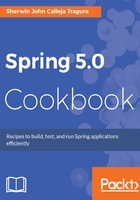
上QQ阅读APP看书,第一时间看更新
How to do it...
In order to create our first controllers, do the following steps:
- Locate pom.xml inside the ch03 folder and configure it to include the entire Spring 5.0 core, Spring Web MVC module, servlet and JSP APIs, JTSL, and standard taglib dependencies:
<properties>
<spring.version>5.0.0.BUILD-SNAPSHOT</spring.version>
<servlet.api.version>3.1.0</servlet.api.version>
</properties>
<dependencies>
<dependency>
<groupId>org.springframework</groupId>
<artifactId>spring-context</artifactId>
<version>${spring.version}</version>
</dependency>
<dependency>
<groupId>org.springframework</groupId>
<artifactId>spring-core</artifactId>
<version>${spring.version}</version>
</dependency>
<dependency>
<groupId>org.springframework</groupId>
<artifactId>spring-beans</artifactId>
<version>${spring.version}</version>
</dependency>
<dependency>
<groupId>org.springframework</groupId>
<artifactId>spring-web</artifactId>
<version>${spring.version}</version>
</dependency>
<dependency>
<groupId>org.springframework</groupId>
<artifactId>spring-webmvc</artifactId>
<version>${spring.version}</version>
</dependency>
<dependency>
<groupId>javax.servlet</groupId>
<artifactId>javax.servlet-api</artifactId>
<version>${servlet.api.version}</version>
<scope>provided</scope>
</dependency>
<dependency>
<groupId>javax.servlet.jsp</groupId>
<artifactId>javax.servlet.jsp-api</artifactId>
<version>2.3.1</version>
<scope>provided</scope>
</dependency>
<dependency>
<groupId>javax.servlet</groupId>
<artifactId>jstl</artifactId>
<version>1.2</version>
</dependency>
<dependency>
<groupId>taglibs</groupId>
<artifactId>standard</artifactId>
<version>1.1.2</version>
</dependency>
// refer to sources
</dependencies>
- Since this project complies with the JavaConfig specification, create the usual SpringWebInitializer to enable MVC configuration and auto-detect all the annotations used by the internal components. Configure @ComponentScan to recognize the base-package org.packt.dissect.mvc.
- Configure also the root ApplicationContext and the SpringDispatcherConfig to auto-detect the @Controller annotations contained in the package org.packt.dissect.mvc.controller through the @ComponentScan.
- Now, create the first type of controller, which is the SimpleController. A simple controller is used to take control of every incoming request using only one URL. The centralized top-level URL setting filters the incoming request and easily identifies the type of HTTP method and headers essential in managing those requests. Let us name this controller SimpleController, having this implementation:
@Controller
@RequestMapping("/simple.html")
public class SimpleController {
@RequestMapping(method=RequestMethod.GET)
public String processGetReq(Model model){
String transactionType = "Simple GET Transaction";
model.addAttribute("transactionType", transactionType);
return "get";
}
@RequestMapping(method=RequestMethod.POST)
public String processPostReq(Model model){
String transactionType = "Simple POST Transaction";
model.addAttribute("transactionType", transactionType);
return "post";
}
}
On the other hand, this SimpleController illustrates how to call two handler methods sharing only one URL, but of different HTTP methods.
- From the preceding code, create the views get and post using ResourceBundleViewResolver. Create and open src\main\resources\config\views.properties and add the following mappings:
post.(class)=org.springframework.web.servlet.view.JstlView post.url=/page/post_view.jsp get.(class)=org.springframework.web.servlet.view.JstlView get.url=/page/get_view.jsp
- Using ReloadableResourceBundleMessageSource, create and open src\main\resources\config\messages_en_US.properties and add the following label mappings:
#Title Labels post_title=POST VIEW get_title=GET VIEW
- After changing the properties file, create the physical view src\main\webapp\page\post_view.jsp for the POST transaction using the following template:
<%@ page language="java" contentType="text/html; charset=ISO-8859-1" pageEncoding="ISO-8859-1"%>
<%@ taglib prefix="spring" uri="http://www.springframework.org/tags" %>
<!DOCTYPE html PUBLIC "-//W3C//DTD HTML 4.01 Transitional//EN" "http://www.w3.org/TR/html4/loose.dtd">
<html>
<head>
<meta http-equiv="Content-Type" content="text/html;
charset=ISO-8859-1">
<title><spring:message code="post_title" /></title>
</head>
<body>
<h1>${ transactionType }</h1>
</body>
</html>
- For the GET transaction, create src\main\webapp\page\get_view.jsp, having the following script:
<%@ page language="java" contentType="text/html;
charset=ISO-8859-1" pageEncoding="ISO-8859-1"%>
<%@ taglib prefix="spring"
uri="http://www.springframework.org/tags" %>
<!DOCTYPE html PUBLIC "-//W3C//DTD HTML 4.01 Transitional//EN" "http://www.w3.org/TR/html4/loose.dtd">
<html>
<head>
<meta http-equiv="Content-Type" content="text/html;
charset=ISO-8859-1">
<title><spring:message code="get_title" /></title>
</head>
<body>
<h1>${ transactionType }</h1>
</body>
</html>
- To execute the handler methods, create a facade controller like this SimpleTestController, as shown here:
@Controller
@RequestMapping("/simplecontroller.html")
public class SimpleTestController {
@RequestMapping(method=RequestMethod.GET)
public String viewTransactions(){
return "simple_list";
}
}
- Implement a physical page for the simple_list view of the previous controller. Name it as src\main\webapp\page\get_view.jsp, with the following script:
<%@ page language="java" contentType="text/html;
charset=ISO-8859-1" pageEncoding="ISO-8859-1"%>
<%@ taglib prefix="spring"
uri="http://www.springframework.org/tags" %>
<!DOCTYPE html PUBLIC "-//W3C//DTD HTML 4.01 Transitional//EN"
"http://www.w3.org/TR/html4/loose.dtd">
<html>
<head>
<meta http-equiv="Content-Type" content="text/html;
charset=ISO-8859-1">
<title><spring:message code="simple_facade" /></title>
</head>
<body>
<a href="${pageContext.request.contextPath}/simple.html">
GET Transaction</a>
<br/>
<form action="${pageContext.request.contextPath}
/simple.html" method="post" >
<input type="submit" value="POST Transaction" />
</form>
</body>
</html>
The ${pageContext.request.contextPath} is an EL expression that retrieves the context path of the deployed web application. This is recommended instead of hardcoding the context.
- Configure the messageSource and viewResolver to include the preceding added components.
- Save all files. clean, build, and deploy the project to your Tomcat 9 application server using our Maven deployment library. Open a browser and run https://localhost:8443/ch03/simplecontroller.html:
